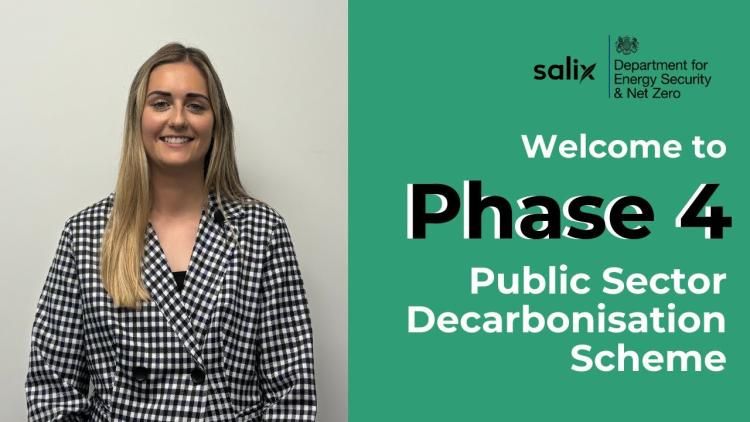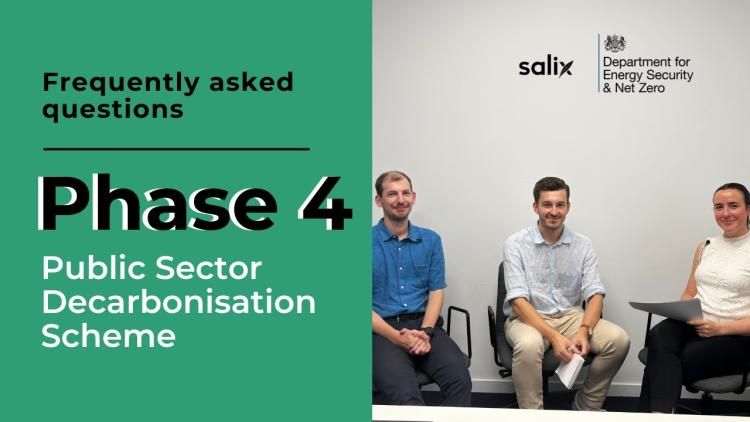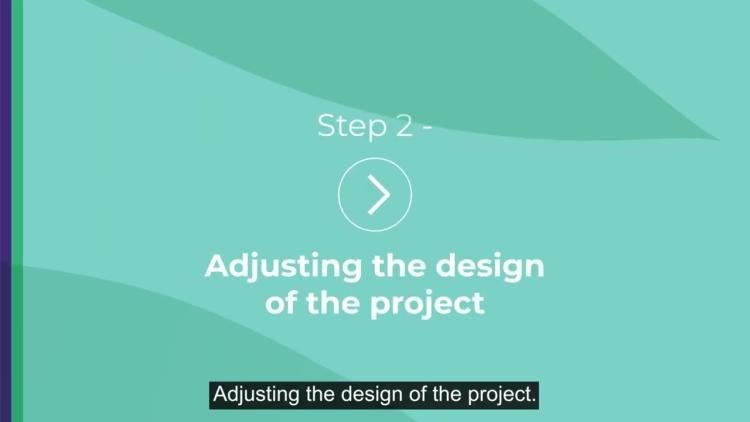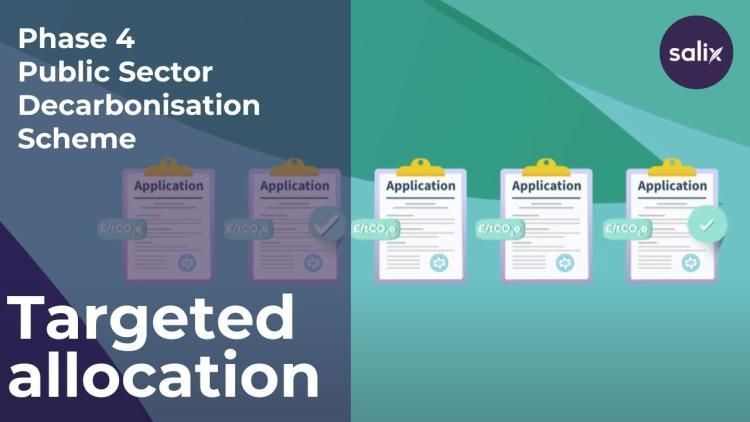Phase 4 Public Sector Decarbonisation Scheme - Applicant Journey Timeline
The applicant journey timeline
Introduction
Welcome to the Phase 4 of the Public Sector Decarbonisation Scheme planner. Our timeline below has been designed to help you progress through your application. We have also included key deadlines, as well as useful documents. Please read the Phase 4 Public Sector Decarbonisation Scheme Guidance Notes for more detailed information on this scheme.
Key Downloads
Step 1
Register for a Salix account
Before you consider applying for Phase 4, please create a portal account through our Salix website. This is where your application will be completed.
We reserve the right to withdraw any application that is not created by a member of the public sector organisation eligible to receive the grant.
Common Queries
I am a returning applicant do I need to register?
Your login and password are the same as when you applied for a previous funding scheme. Please go to the Salix Application Portal and check you have the correct username and password. Once you have logged in you will be able to view your application history through “My Salix.” Check your login.
I have forgotten my password can I reset this?
Yes, you can reset your password. You should receive an automatic email asking you to reset your password, if you have not received one, please email [email protected] for further support.
Step 2
Identification of a suitable building/site
The process of creating a successful Public Sector Decarbonisation Scheme project must start with identifying the organisation’s suitable buildings for a heat decarbonisation project. A suitable building should follow the eligibility and project criteria as detailed in the Phase 4 Public Sector Decarbonisation Scheme Guidance Notes.
You should prioritise buildings based on the following criteria:
- Condition and age of the existing fossil fuel heating plant
- Building retention and occupation
If you have participated in the Low Carbon Skills Fund we encourage you to use your existing Heat Decarbonisation Plans (HDPs) in your Public Sector Decarbonisation Scheme application.
For more information of how to develop your application please see the Phase 4 Public Sector Decarbonisation Scheme Guidance Notes (Section 3).
Key pages on the website:
Step 3
Internal discussions and decision making
At this stage, it is important to establish the internal governance structure that will lead the initial discussions. This includes:
- Establishing an Authorising Official who has the authority to approve and sign-off on official finance and legal documentation. This could be a director of finance, chief financial officer, Section 151 officer or headteacher.
- Establishing a main contact, who will be responsible for overseeing the project and who will be in regular contact with our team at Salix.
- Developing and understanding the process for securing internal board approval.
- Early engagement with the internal procurement and planning department. If you are unsure, Crown Commercial Service (CCS) has two compliant routes to market that can support public sector organisations with their decarbonisation targets (RM6313 and RM6314).
Key pages on the website:
Step 4
View our webinar slides
We hosted twelve webinars, designed to provide guidance on the funding scheme and support to eligible applicants. The webinar slides are now available for download.
Step 5
Watch our guidance videos
We have created a series of guidance videos for Phase 4 of the Public Sector Decarbonisation Scheme. We strongly recommend you watch these and familiarise yourself with the application process.
- Introduction and guidance video
- Frequently asked questions video
- Calculating carbon cost explanatory video
- Targeted allocation explanatory video

Welcome to Phase 4 of the Public Sector Decarbonisation Scheme introduction and guidance video.

In this video, we will be going through some frequently asked questions relating to Phase 4 of the Public Sector Decarbonisation Scheme.


Step 6
Considerations for initial project design
Phase 4 of the Public Sector Decarbonisation Scheme was announced on 29 February 2024. The application window for Phase 4 of the Public Sector Decarbonisation Scheme opened on Wednesday 9 October 2024 at 2pm. The portal closed on Monday 25 November 2024 at 2pm.
You are encouraged to become familiar with the Phase 4 Guidance Notes, application form and required supporting documents. During this time, collect all the required documents, think about the quality of your project, and the steps you have taken to ensure its deliverability by the required deadlines.
Consortium bids are required to complete the Consortium Documentation tab of the application form as part of their Phase 4 Public Sector Decarbonisation Scheme application.
Key considerations:
- Collecting building baseline information (gas and electric consumption, building fabric information and heating plant details).
- Ensuring the buildings are suitable for low-carbon heating plant, assessed through detailed building surveys and feasibility studies.
- Ensuring the adoption of a whole-building approach to reduce the building’s heating and electrical demand.
- Identifying the most effective low-carbon heating solution (I.e., using an options appraisal of heating options and domestic hot water requirements).
- Producing detailed feasibility studies (pre-tender) or detailed designs (post-tender) for the low-carbon solution identified.
- Collecting all the required supporting evidence and information, in the accepted formats
- Assessing current and required electrical capacity and early engagement with the Distribution Network Operator.
- Assessing the organisation’s capacity to cover the required recipient contribution by calculating the total project value, grant value and required 12% applicant contribution. This can be done by obtaining preliminary quotes for project costs and adding these to a copy of the Phase 4 Public Sector Decarbonisation Scheme Application Form.
- Finalising internal approval for the project and recipient contribution.
Project milestones
The application form will request you to provide expected completion dates and the grant value associated with these milestones. These project milestones are used throughout the process until completion and are defined below:
Project approval - Internal approvals from the Board, Finance, PFI, and all necessary approvers for all measures, have been obtained.
This milestone is typically expected to be reached by the time that the Salix Grant Offer Letter has been received. If this is not forecasted to be the case, we might request assurance of approvals.
Designs initiated - The initial concept designs, spatial coordination and feasibility studies for the application’s measures have begun and detailed designs are being prepared. It could be the case that this milestone has already been achieved through previous Low Carbon Skills Fund funding.
Detailed design complete - Final detailed designs are fully completed. This includes details of equipment size, specifications, performance and cost.
Out to tender - Tenders have been submitted and contractors are in the process of bidding.
Note: this can be in the form of different types of procurement routes, including but not limited to a mini competition/call off contract if you are utilising a Framework, or direct contract if you are part of a central purchasing body, etc.
Tenders complete - Tender has ended and bids for the delivery of the project’s measures have been evaluated. The chosen contractor and the firm costs relevant to this measure have been approved, and the contract has been awarded.
Order placed - The contractor has placed orders for the materials, technology, and equipment required for all measures.
Work in progress - All required equipment for the installation of the project’s measures is on-site, and contractors are in the process of installing it.
Completed on site - All equipment related to the projects’ measures is installed and the equipment can now be tested for its operational features.
Final commissioning - The equipment has been tested and works as per its design. All final snagging works have completed, and the technology is operational.
Note: This should be the final date referenced in the project’s full delivery.
Key Downloads
Step 7
Application portal opening
***The application portal is now closed***
To begin the application process, you must log into your account. Please fill out the key information and upload the required and supporting documents.
The application process must be completed by the public sector organisation, not the consultants involved in the project.
With all the information correctly completed and the supporting documents uploaded, you can submit the whole application. You will be able to save a draft and edit your application up until the portal close date of 25 November 2024.
The application portal has introduced a queuing system. This means that if the portal is experiencing a high volume of users, you will be placed in a queuing system before you can enter the portal. You are encouraged to submit an application to the portal only when you are confident all necessary information and documentation has been uploaded, well before the portal closure date and time.
Mandatory documents:
- Fully populated application form
- Cost evidence (itemised cost breakdown for CAPEX)
- Energy savings calculations for all measures
- End-of-life heating plant evidence
- Project programme
- Peak heat loss calculations or peak heat demand profile
- Feasibility study, including detailed options appraisal
- Manufacturer data sheets for all measures including proposed low carbon heating technology
- Building energy consumption* (meter data, historic bills, DEC)
- Risk register
- Counter fraud declaration
- Project execution plan
- Schematics of existing and proposed heating system
- Procurement status evidence (if applying on behalf of a higher education institution)
- Leasehold renewal evidence (if applicable)
- Other supporting information such as but not limited to evidence of Distribution Network Operator engagement, quotations, leasehold agreement extension evidence, etc..
Step 8
Initial quality checks
After the application portal closes, our team will begin initial quality checks on applications. This check will ensure your application meets the minimum criteria and that all mandatory documents are attached. If an application fails at this stage, it will be withdrawn from the scheme, and you will be contacted by us. This decision is likely to take place before an assessor has had any contact with the applicant.
Please note that while you can submit more than one application, any duplicates will be withdrawn at this stage before applications are given a ranking by a targeted allocation. Please refer to section 2.2 of the guidance notes for further details on targeted allocation alongside this targeted allocation video.
Projects that have been unsuccessful at this stage will be formally notified via email and provided feedback on their application.
Step 9
Project assessment
At this stage, projects will be assessed according to the order assigned following the targeted allocation process. We have various external technical assessors who you should expect queries from. You must respond to queries within four working days. Failure to respond within this timeframe will trigger an escalation process, which may result in an application being withdrawn from the process. Projects may also be subject to a delivery call. If you do not have a delivery call you will be expected to confirm the delivery of your project via an email directly from our team. It is crucial that you are available to respond to queries and that any risks or issues are flagged at this stage.
Unsuccessful applications will be informed of the assessment outcome by our team and feedback will be provided.
Applicants that engage in any economic activity or are currently leasing a site to an enterprise may be eligible for Phase 4 Public Sector Decarbonisation Scheme funding. If the works funded by the grant directly impact any economic activity they are undertaking, the applicant must cooperate with our team at Salix to ensure compliance with the Subsidy Control Act 2022.
Information related to enterprises will be assessed by our team, and you may be required to provide further information pertaining to the enterprises on site, such as Direct and Indirect Minimal Finance Assistance declarations or a Windsor Framework declaration.
Any applications that include leased buildings may also be subject to further queries from our team about the leasehold agreement's terms. You should therefore ensure that they, and the enterprise or third building party-owners, are available to resolve any queries.
Step 10
Awarding Grant Offer Letters
If a project passes assessment, and provided it falls in the available funding pot, it will be awarded a Grant Offer Letter. These letters detail key information about the grant, as well as the specific aspects of the project, and they must be signed through DocuSign by the Authorising Official within 10 working days of being sent. Grant Offer Letters will also stipulate the project specific conditions that must be met by the grant holders. These will be a requirement for every project to receive grant funding.
We aim to award all successful application funding by approximately the end of May 2025.
Step 11
Project delivery
All grant recipients will be allocated a relationship manager to support the delivery of the project and provide scheme guidance. Grant recipients are expected to have regular monthly catch ups with their relationship manager and to submit Monthly Monitoring Reports. These reports provide us with valuable updates regarding the progress of your project, the key risks and issues, as well as any adjustments to the upcoming forecasted payment claims.
Grant recipients will also be required to provide evidence to fulfil the conditions outlined in the Grant Offer Letter, by the date stipulated. Fulfilment of these conditions is necessary to make payment requests and continue drawing down funds to deliver the project.
*Project changes must be flagged with relationship managers and formally submitted as a Change Request (scope changes are subject to a technical reassessment).
Below you will be able to find the Phase 3c guidance for Monthly Monitoring Reports, requesting Salix funds and change requests. While we are expecting to update these in due course for Phase 4, you can review them as a guide on what to expect during project delivery.
Step 12
Completion process
Your grant end date will be outlined in your Grant Offer Letter and will either be; 31 March 2026, 31 March 2027 or 31 March 2028.
*Grant funding cannot be moved between financial years. Any funding not spent in the financial year for which it was allocated in your Grant Offer Letter will be lost.
We will be updating the guidance on project closure and claiming your final phase 4 grant payment, but please be aware that it is expected that to claim your final grant payment, grant recipients will need to provide the following documents:
- Final invoices
- Final statement of expenditure
- Signed Schedule 5 form, found in your Grant Offer Letter
- Evidence to close any outstanding conditions
- Contractor completion certificates of installation
- Warranty certificates for installed measures
- Evidence of your minimum recipient contribution paid into the project
To close your project, you will be required to submit the following documents:
- Photographic evidence of measures installed
- Contractor completion certificates of installation
- Warranty certificates for installed measures
- Evidence of your minimum recipient contribution paid into the project
Please note, if your project is delayed, we would still require evidence to close all outstanding conditions to process your final grant payment.
Failure to submit requested documents could result in your final payment being withheld.
Step 13
Post-completion monitoring and reporting
Applicants will be required to provide annual monitoring data for three years after measures have been installed. The purpose of this is to measure projects’ carbon savings against the expectation from the design. This information will support us in better understanding the impact of the Public Sector Decarbonisation Scheme. Further information on this will be provided.
Key items to report:
- The outcomes of the measures.
- Any retention payments to contractors.
Information on Audits
As stewards of public money, at Salix we have the responsibility to ensure that all grants are being used for their intended purpose. A sample of the awarded grants will be audited by our team, the outcomes of which will be reported to the Department for Energy Security and Net Zero. This is to ensure that public money is safeguarded, grant outcomes are achieved and informs future programmes and guidance. Non-compliance or breaches to the scheme conditions may result in the recovery of funds.
All grant recipients should maintain accurate records of costs and expenditure so these can be produced should they be audited. The audits also comprise a site visit by technical consultants to confirm the project implementation. These can take place during project implementation or at project completion.
Key records and documents (non-extensive):
- Procurement records
- Tender documents
- Financial documents
- Breakdown of costs
